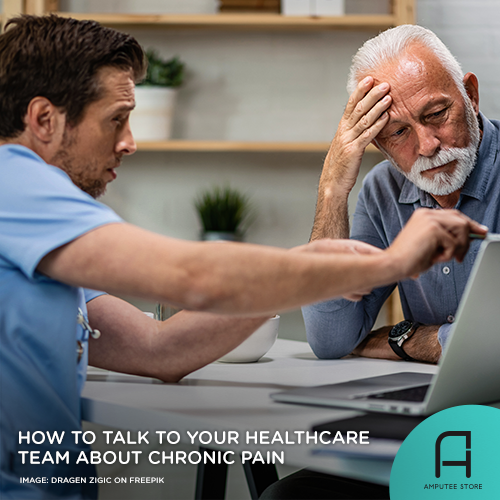How to Talk to Your Healthcare Team About Chronic Pain
Navigating chronic pain, especially for a person living with limb loss, can be challenging. Chronic pain varies in cause, duration, frequency, location, and sensation. And many face challenges relaying this information to others, as well as being seen and heard.

Communication is the first step towards finding medical strategies that work. In this article, we discuss various methods you can adopt to help you effectively communicate about chronic pain. We also talk about strategies to help you manage your chronic pain, which can help when you’re in between appointments.
Keep a pain journal
A pain diary can make communication with your healthcare team more accurate and efficient. You can choose to keep a digital or pen-and-paper pain journal to take note of the following:
-
When did the pain start or end? What triggered it? What alleviated it?
-
Describe the intensity of the pain using the standard numerical 0 to 10 scale—0 means no pain, 1 to 3 means mild pain, 4 to 7 means moderate pain, and 8 to 10 means severe pain. Besides the intensity, also take note of the sensation and pinpoint the location of the pain.
-
Take note of factors that could have played a role in your pain. What did you eat? What were your activity levels? Have you had a challenging physical therapy session lately?
-
Also, note what your pain caused, such as appetite changes, a fall, loss of balance, insomnia, or an inability to concentrate.
Prepare for your appointments
Time with healthcare providers is limited, so make a plan. Create a list of issues you want to address and prioritize those issues. There is a limit to the number of issues that can be addressed with every visit.
You can have a family member or friend accompany you to your appointments. Having another person in the room will offer you support and ensure that communication with your healthcare provider is accurate. You can also ask your companion to take notes so you’re free to focus on the conversation, or you can compare notes afterward.
Organize your papers
After your appointment, make sure to get written follow-up instructions. This will help you recall important details from your visit, such as test results, new test orders, referrals, and medication changes.
Put all these, plus your notes, in a binder or an envelope. Having everything in one place will be helpful in emergencies. You can also keep digital copies for easy access anytime.
Managing chronic pain
Living with chronic pain in between appointments with your healthcare provider requires knowing how to manage and live with your chronic pain. The strategies below can help you manage your pain, energy, and mental health.
Manage your energy with the Spoon Theory
Developed in 2003 by writer Christine Miserandino, the Spoon Theory uses spoons as a metaphor to represent the limited physical and mental energy that people with chronic pain have daily. Miserandino has lupus, which affects her ability to perform daily tasks.
According to the Spoon Theory, small tasks like getting dressed or making breakfast may only require one spoon, while larger tasks like laundry or cleaning the house may take several spoons. Even simple tasks can require multiple spoons on days when pain levels are higher.
This theory emphasizes the importance of self-pacing for people with chronic pain, as they have to be strategic about how they use their spoons throughout the day. It’s all about being economical and working within a certain quota to ensure you have enough energy to make it through the day.
Delve into hobbies
Chronic pain is challenging, so it’s essential to find activities that replenish you physically, emotionally, and spiritually.
Exercising, even a brisk walk, is a great way to replenish your mental and physical energy. If you’re into yoga, check out the Yoga for Amputees website. They offer free weekly virtual sessions. Also, check your local limb loss community for adaptive sports clinics.
Other options to help recharge your energy are learning a new language, playing a new instrument, or taking pottery classes. Studies have shown that working with your hands can relieve stress. Faith-based engagement opportunities are also great for filling your emotional and spiritual cup. It also helps you gain new connections along the way.
Cultivate mental health
Chronic pain can take a toll on your overall well-being. Practices like deep breathing, meditation, or mental health practices like talk therapy or cognitive behavioral therapy can significantly contribute to relieving pain, even just a bit.
You might want to check out some breathing exercises to incorporate into your day. Furthermore, lean into music and art as these can be great tools for when your anxiety and frustration peak. Create a soothing playlist or curate a reading list or a “watch later” list on your video streaming platform of choice.
It’s okay not to be okay
Living with chronic pain can be exhausting, so don’t be so hard on yourself. It’s okay to take an hour or a day to recover and charge your internal batteries.
If you need help, it’s okay to reach out to a trusted friend or family member, a crisis center, or the emergency department. When the situation feels difficult, you might want to visit 988lifeline.org to chat with a trained counselor.










































































